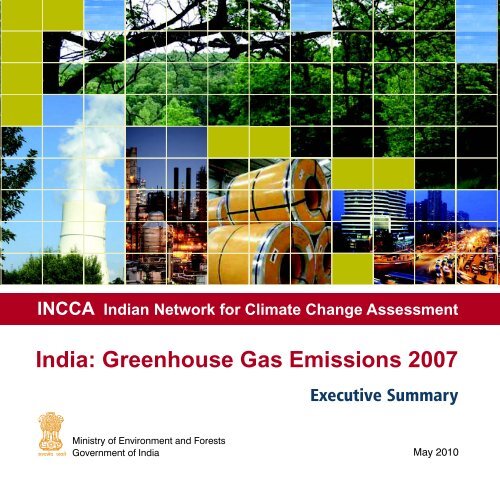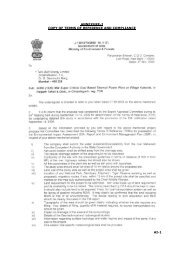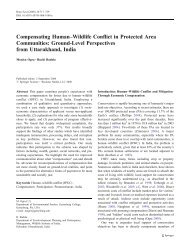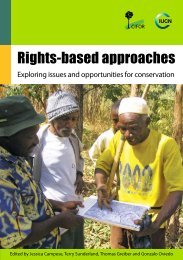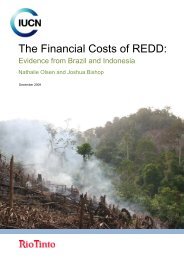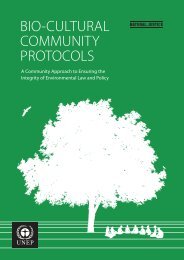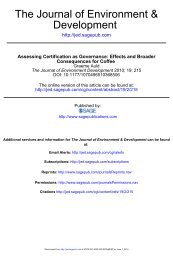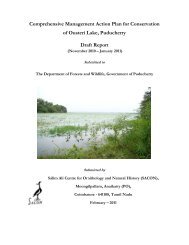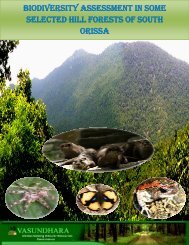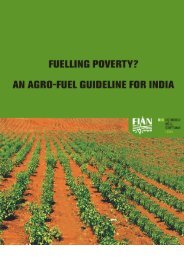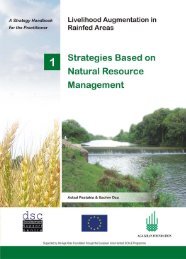India: Greenhouse Gas Emissions 2007 - Ministry of Environment ...
India: Greenhouse Gas Emissions 2007 - Ministry of Environment ...
India: Greenhouse Gas Emissions 2007 - Ministry of Environment ...
You also want an ePaper? Increase the reach of your titles
YUMPU automatically turns print PDFs into web optimized ePapers that Google loves.
INCCA <strong>India</strong>n Network for Climate Change Assessment<br />
<strong>India</strong>: <strong>Greenhouse</strong> <strong>Gas</strong> <strong>Emissions</strong> <strong>2007</strong><br />
Executive Summary<br />
<strong>Ministry</strong> <strong>of</strong> <strong>Environment</strong> and Forests<br />
Government <strong>of</strong> <strong>India</strong> May 2010
INCCA <strong>India</strong>n Network for Climate Change Assessment<br />
<strong>India</strong>: <strong>Greenhouse</strong> <strong>Gas</strong> <strong>Emissions</strong> <strong>2007</strong><br />
Executive Summary<br />
<strong>Ministry</strong> <strong>of</strong> <strong>Environment</strong> and Forests<br />
Government <strong>of</strong> <strong>India</strong> May 2010
Foreword<br />
I am pleased to introduce the<br />
publication – <strong>India</strong>’s <strong>Greenhouse</strong><br />
<strong>Gas</strong> <strong>Emissions</strong> <strong>2007</strong>. This Report,<br />
being brought out by the <strong>India</strong>n<br />
Network <strong>of</strong> Climate Change<br />
Assessment (INCCA), provides<br />
updated information on <strong>India</strong>’s <strong>Greenhouse</strong> <strong>Gas</strong><br />
<strong>Emissions</strong> for the year <strong>2007</strong>. Until today, the only <strong>of</strong>ficial<br />
emissions estimates available were for the year 1994. This<br />
was very inadequate. I had been keen that to enable<br />
informed decision-making and to ensure transparency,<br />
we should publish updated emissions estimates. I am glad<br />
that our team <strong>of</strong> scientists took up this challenge and<br />
have prepared this report with estimates for <strong>2007</strong> in<br />
record time. More than 80 scientists from 17 institutions<br />
across <strong>India</strong> have contributed to this Assessment. I am<br />
particularly pleased that with this publication, <strong>India</strong> has<br />
become the first “non-Annex I” (i.e. developing) country<br />
to publish such updated numbers. I am also happy to<br />
announce that we will publish our emissions inventory in a<br />
two-year cycle going forward. We will be the first<br />
developing country to do so.
According to the results, <strong>India</strong> ranks 5 th in aggregate GHG<br />
emissions in the world, behind USA, China, EU and Russia<br />
in <strong>2007</strong>. Interestingly, the emissions <strong>of</strong> USA and China<br />
are almost 4 times that <strong>of</strong> <strong>India</strong> in <strong>2007</strong>. It is also<br />
noteworthy that the emissions intensity <strong>of</strong> <strong>India</strong>’s GDP<br />
declined by more than 30% during the period 1994-<br />
<strong>2007</strong>, due to the efforts and policies that we are<br />
proactively putting in place. This is a trend we intend to<br />
continue. As you are aware, we have already announced<br />
our intent to further reduce the emissions intensity <strong>of</strong><br />
our GDP by 20-25% between 2005 and 2020 even as<br />
we pursue the path <strong>of</strong> inclusive growth.<br />
INCCA, launched on 14 th October 2009, is a network<br />
comprising 127 research institutions, tasked with<br />
undertaking research on the science <strong>of</strong> climate change<br />
and its impacts on the different sectors <strong>of</strong> the economy<br />
across the various regions <strong>of</strong> <strong>India</strong>. As I mentioned at<br />
the launch, we must make the “3 M’s” – Measurement,<br />
Modelling and Monitoring – the essence <strong>of</strong> our policy<br />
making and we must build indigenous capacity for this.<br />
This report is a step in this direction. I look forward to<br />
INCCA’s next major publication – a “4X4” assessment<br />
<strong>of</strong> the impacts <strong>of</strong> climate change on four sectors – water<br />
resources, agriculture, forests and human health – in four<br />
critical regions <strong>of</strong> <strong>India</strong> – the Himalayan region, North<br />
east, Western Ghats and Coastal <strong>India</strong>, which will be<br />
released in November 2010.<br />
Once again, I congratulate our team <strong>of</strong> scientists who<br />
have put this assessment together. I look forward to the<br />
results <strong>of</strong> the other upcoming studies <strong>of</strong> INCCA.<br />
Jairam Ramesh<br />
Minister <strong>of</strong> State for <strong>Environment</strong> & Forests<br />
(Independent Charge)
Executive Summary<br />
This assessment provides information on <strong>India</strong>’s emissions<br />
<strong>of</strong> <strong>Greenhouse</strong> gases (Carbon Dioxide [CO 2<br />
], Methane<br />
[CH 4<br />
] and Nitrous Oxide [N 2<br />
O]) emitted from<br />
anthropogenic activities at national level from:<br />
■ Energy;<br />
■ Industry;<br />
■ Agriculture;<br />
■<br />
■<br />
Waste; and<br />
Land Use Land Use Change & Forestry (LULUCF).<br />
The distribution <strong>of</strong> GHG emissions by sector are shown in<br />
Figure ES1. Detailed emissions estimates are provided in<br />
Annexure.<br />
Note:<br />
Other Energy: includes GHG emissions from petroleum refining, manufacturing <strong>of</strong> solid fuel, commercial & institutional sector, agriculture & fisheries and fugitive<br />
emissions from mining, transport and storage <strong>of</strong> coal, oil and natural gas.<br />
Other Industry: includes GHG emissions from production <strong>of</strong> glass and ceramics, soda ash, ammonia, nitric acid, carbides, titanium dioxide, methanol, ethylene<br />
oxide, acrylonitrile, carbon black, caprolactam, ferro alloys, aluminium, lead, zinc, copper, pulp and paper, food processing, textile, leather, mining and quarrying,<br />
non specific industries and use <strong>of</strong> lubricants and paraffin wax.<br />
Agriculture: includes GHG emissions from livestock, rice cultivation, agricultural soils and burning <strong>of</strong> crop residue.<br />
Waste: includes GHG emissions from municipal solid waste (MSW), industrial and domestic waste water.<br />
LULUCF: includes GHG emissions and removals from changes in forest land, crop land, grass land, wet land, settlements and combustion <strong>of</strong> fuel wood in<br />
forests.<br />
Figure ES1: GHG emissions by sector in <strong>2007</strong> (million tons <strong>of</strong> CO 2<br />
eq). Figures on top indicate the emissions by sectors and in brackets<br />
indicate % <strong>of</strong> emission <strong>of</strong> the category with respect to the net CO 2<br />
equivalent emissions. See glossary for defination <strong>of</strong> CO 2<br />
equivalent.<br />
<strong>India</strong>n Network for Climate Change Assessment<br />
Page 64
A. KEY RESULTS<br />
■ The net <strong>Greenhouse</strong> <strong>Gas</strong> (GHG) emissions from <strong>India</strong><br />
in <strong>2007</strong>, that is emissions with LULUCF, were 1727.71<br />
million tons <strong>of</strong> CO 2<br />
equivalent (eq) <strong>of</strong> which<br />
- CO 2<br />
emissions were 1221.76 million tons;<br />
- CH 4<br />
emissions were 20.56 million tons; and<br />
- N 2<br />
O emissions were 0.24 million tons<br />
■ GHG emissions from Energy, Industry, Agriculture, and<br />
Waste sectors constituted 58%, 22%, 17% and 3% <strong>of</strong><br />
the net CO 2<br />
eq emissions respectively.<br />
■ Energy sector emitted 1100.06 million tons <strong>of</strong> CO 2<br />
eq,<br />
<strong>of</strong> which 719.31 million tons <strong>of</strong> CO 2<br />
eq were emitted<br />
from electricity generation and 142.04 million tons <strong>of</strong><br />
CO 2<br />
eq from the transport sector.<br />
■ Industry sector emitted 412.55 million tons <strong>of</strong> CO 2<br />
eq.<br />
■ LULUCF sector was a net sink. It sequestered 177.03<br />
million tons <strong>of</strong> CO 2<br />
.<br />
■ <strong>India</strong>’s per capita CO 2<br />
eq emissions including LULUCF<br />
were 1.5 tons/capita in <strong>2007</strong>.<br />
B. 1994 AND <strong>2007</strong> GHG EMISSIONS - A<br />
COMPARISON<br />
The 1994 assessment is available in <strong>India</strong>’s Initial National<br />
Communication to the UNFCCC. Both the 1994 and <strong>2007</strong><br />
assessments have been prepared using the IPCC guidelines<br />
for preparation <strong>of</strong> national greenhouse gas emissions by<br />
sources and removal by sinks. The distinctive key features <strong>of</strong><br />
the two assessments and the improvements in the <strong>2007</strong><br />
assessments are indicated in Box ES1.<br />
The total GHG emissions without LULUCF have grown from<br />
1251.95 million tons in 1994 to 1904.73 million tons in <strong>2007</strong><br />
at a compounded annual growth rate (CAGR) <strong>of</strong> 3.3% and<br />
with LULUCF the CAGR is 2.9%. Between 1994 and <strong>2007</strong>,<br />
some <strong>of</strong> the sectors indicate significant growth in GHG<br />
emissions such as cement production (6.0%), electricity<br />
generation (5.6%) and transport (4.5%). A comparative<br />
analysis <strong>of</strong> GHG emissions by sector is shown in Table ES1.<br />
Box ES1: <strong>2007</strong> and 1994 - Key Methodological Features and Improvements<br />
1994 Assessment<br />
<strong>2007</strong> Assessment<br />
■<br />
■<br />
■<br />
■<br />
■<br />
Estimates made using only revised 1996 IPCC guidelines.<br />
LULUCF included emissions from changes in forest land.<br />
Emission factors were a mix <strong>of</strong> default factors taken from<br />
IPCC and country specific (CS) emission factors. 26% <strong>of</strong> the<br />
source categories used CS factors.<br />
The 1994 assessment splits the emissions from industry in to<br />
two parts - fossil fuel and process. The fossil fuel emissions<br />
are reported in Energy and process emissions in Industry.<br />
In 1994, 7% <strong>of</strong> the total CO 2<br />
eq emissions were made using<br />
Tier III approach.<br />
■ Estimates made using revised IPCC 1996 guidelines (1997),<br />
IPCC Good Practice Guidance (2000), the LULUCF Good<br />
Practice Guidance (2003).<br />
■<br />
■<br />
■<br />
■<br />
Carbon pools in addition to forests have been considered in<br />
the LULUCF sector (crop land, grass land, settlements).<br />
Emission factors were also a mix <strong>of</strong> default and CS but<br />
leading to improved accuracy as more number <strong>of</strong> CSs have<br />
been used in this assessment (35% <strong>of</strong> the source categories<br />
used CS factors).<br />
The <strong>2007</strong> assessment reports both fossil fuel related and<br />
process based emissions from Industry as a part <strong>of</strong> the<br />
Industry sector.<br />
In <strong>2007</strong>, 12% <strong>of</strong> the emissions are made using Tier III<br />
approach, implying greater accuracy.<br />
Page 75<br />
<strong>India</strong>: <strong>Greenhouse</strong> <strong>Gas</strong> <strong>Emissions</strong> <strong>2007</strong>
Table ES1: A comparison <strong>of</strong> GHG emissions by sector between 1994 and <strong>2007</strong> in million tons <strong>of</strong> CO 2<br />
eq.<br />
1994 <strong>2007</strong> CAGR (%)<br />
Electricity 355.03 (28.4%) 719.30 (37.8%) 5.6<br />
Transport 80.28 (6.4%) 142.04 (7.5%) 4.5<br />
Residential 78.89 (6.3%) 137.84 (7.2%) 4.4<br />
Other Energy 78.93 (6.3%) 100.87 (5.3%) 1.9<br />
Cement 60.87 (4.9%) 129.92 (6.8%) 6.0<br />
Iron & Steel 90.53 (7.2%) 117.32 (6.2%) 2.0<br />
Other Industry 125.41 (10.0%) 165.31 (8.7%) 2.2<br />
Agriculture 344.48 (27.6%) 334.41 (17.6%) -0.2<br />
Waste 23.23 (1.9%) 57.73 (3.0%) 7.3<br />
Total without LULUCF 1251.95 1904.73 3.3<br />
LULUCF 14.29 -177.03<br />
Total with LULUCF 1228.54 1727.71 2.9<br />
Note: Figure in brackets indicate percentage emissions from each sector with respect to total GHG emissions<br />
without LULUCF in 1994 and <strong>2007</strong> respectively<br />
C. IMPLEMENTATION ARRANGEMENT<br />
This assessment has been prepared under the aegis <strong>of</strong> the<br />
<strong>India</strong>n Network for Climate Change Assessment (INCCA).<br />
An initiative being coordinated by the <strong>Ministry</strong> <strong>of</strong><br />
<strong>Environment</strong> and Forests, Government <strong>of</strong> <strong>India</strong>. (Box ES2 &<br />
Figure ES2).<br />
D. SECTORAL DESCRIPTION OF THE EMISSIONS<br />
Energy: The energy sector emitted 1100.06 million tons <strong>of</strong><br />
CO 2<br />
eq due to fossil fuel combustion in electricity<br />
generation, transport, commercial/Institutional<br />
establishments, agriculture/fisheries, and energy intensive<br />
industries such as petroleum refining and manufacturing <strong>of</strong><br />
solid fuels, including biomass use in residential sector.<br />
Fugitive emissions from mining and extraction <strong>of</strong> coal, oil<br />
Box ES2: <strong>India</strong>n Network for Climate<br />
Change Assessment (INCCA)<br />
Launched on October 14, 2009, the network comprises<br />
<strong>of</strong> 127 institutions and 228 scientists across <strong>India</strong><br />
Role<br />
- Assess the drivers and implications <strong>of</strong> climate change<br />
through scientific research<br />
- Prepare climate change assessments once every two<br />
years (GHG estimations and impacts <strong>of</strong> climate<br />
change, associated vulnerabilities and adaptation)<br />
- Develop decision support systems<br />
- Build capacity towards management <strong>of</strong> climate<br />
change related risks and opportunities<br />
<strong>India</strong>n Network for Climate Change Assessment<br />
Page 86
<strong>2007</strong> Assessment<br />
BCKV Bidhan Chandra Krishi Viswavidyalaya<br />
CII Confederation <strong>of</strong> <strong>India</strong>n Industry<br />
CIMFR Central Institute <strong>of</strong> Mining & Fuel Research<br />
CLRI Central Leather Research Institute<br />
CMA Cement Manufacturing Association<br />
CRRI Central Road Research Institute<br />
FSI Forest Survey <strong>of</strong> <strong>India</strong><br />
IARI <strong>India</strong>n Agricultural Research Institute<br />
IGFRI <strong>India</strong>n Grass & Fodder Research Institute<br />
IISc <strong>India</strong>n Institute <strong>of</strong> Science<br />
IVRI <strong>India</strong>n Veterinary Research Institute<br />
NDRI National Dairy Research Institute<br />
NEERI National <strong>Environment</strong> Engineering Research<br />
Institute<br />
NPL National Physical Laboratory<br />
NRSC National Remote Sensing Centre<br />
PPAC Petroleum Planning and Analysis Cell<br />
TERI The Energy and Resources Institute<br />
Figure ES2: INCCA and Network for preparing the <strong>Greenhouse</strong> <strong>Gas</strong> <strong>Emissions</strong> <strong>2007</strong>. For the complete list <strong>of</strong> institutions<br />
participating in INCCA, see Annexure 4 <strong>of</strong> the main document.<br />
Page 97<br />
<strong>India</strong>: <strong>Greenhouse</strong> <strong>Gas</strong> <strong>Emissions</strong> <strong>2007</strong>
Figure ES3: GHG emissions from Energy Sector (million tons <strong>of</strong> CO 2<br />
eq).<br />
and natural gas are also accounted for in the energy sector.<br />
The distribution <strong>of</strong> the emissions across the source<br />
categories in energy sector is shown in Figure ES3.<br />
Electricity Generation: The total greenhouse gas emissions<br />
from electricity generation in <strong>2007</strong> was 719.31 million tons<br />
CO 2<br />
eq. This includes both grid and captive power. The CO 2<br />
eq emissions from electricity generation were 65.4% <strong>of</strong> the<br />
total CO 2<br />
eq emitted from the energy sector. Coal constituted<br />
about 90% <strong>of</strong> the total fuel mix used.<br />
Petroleum Refining and Solid Fuel Manufacturing: These<br />
energy intensive industries emitted 33.85 million tons <strong>of</strong><br />
CO 2<br />
eq in <strong>2007</strong>. The solid fuels include manufacturing <strong>of</strong><br />
coke & briquettes.<br />
Transport: The transport sector emissions are reported from<br />
road transport, aviation, railways and navigation. In <strong>2007</strong>,<br />
the transport sector emitted 142.04 million tons <strong>of</strong> CO 2<br />
eq.<br />
Road transport, being the dominant mode <strong>of</strong> transport in<br />
the country, emitted 87% <strong>of</strong> the total CO 2<br />
equivalent<br />
emissions from the transport sector. The aviation sector in<br />
comparison only emitted 7% <strong>of</strong> the total CO 2<br />
eq emissions.<br />
The rest were emitted by railways (5%) and navigation (1%)<br />
sectors. The bunker emissions from aviation and navigation<br />
have also been estimated but are not counted in the national<br />
totals. (Figure ES4).<br />
Residential & Commercial: The residential sector in <strong>India</strong><br />
is one <strong>of</strong> the largest consumers <strong>of</strong> fuel outside the energy<br />
industries. Biomass constitutes the largest portion <strong>of</strong> the<br />
total fuel mix use in this sector. Commercial and institutional<br />
sector uses oil & natural gas over and above the<br />
conventional electricity for its power needs. The total CO 2<br />
eq emission from residential & commercial/institution sector<br />
was 139.51 million tons <strong>of</strong> CO 2<br />
eq in <strong>2007</strong>.<br />
Agriculture & Fisheries: The agriculture/ fisheries activities<br />
together emitted 33.66 million tons <strong>of</strong> CO 2<br />
eq due to energy<br />
use in the sector other than grid electricity.<br />
<strong>India</strong>n Network for Climate Change Assessment<br />
Page 108
Figure ES4: GHG emissions from Transport Sector by mode <strong>of</strong><br />
transport in <strong>2007</strong> (million tons <strong>of</strong> CO 2<br />
eq).<br />
Fugitive <strong>Emissions</strong>: CH 4<br />
escapes into the atmosphere due<br />
to mining <strong>of</strong> coal, and due to venting, flaring, transport and<br />
storage <strong>of</strong> oil and natural gas. The total CO 2<br />
eq emissions<br />
from this source category in <strong>2007</strong> was 31.70 million tons<br />
CO 2<br />
eq.<br />
Industry: Industrial activities together emitted 412.55 million<br />
tons <strong>of</strong> CO 2<br />
eq <strong>of</strong> GHG in <strong>2007</strong>. Industry sector emissions<br />
have been estimated from manufacturing <strong>of</strong> minerals,<br />
metals, chemicals, other specific industries, and from nonenergy<br />
product use. The emissions covered in the industry<br />
sector include fossil fuel combustion related emissions as<br />
well as the process based emissions. (Figure ES5).<br />
Cement and Other Minerals: The cement industry emitted<br />
129.92 million tons <strong>of</strong> CO 2<br />
, which is 32% <strong>of</strong> the total CO 2<br />
eq emissions from the Industry sector. The emissions cover<br />
the entire technology mix for manufacturing <strong>of</strong> cement in<br />
the country covering large, medium and white cement<br />
Note:<br />
Other Metals: includes GHG emissions from production <strong>of</strong><br />
ferroalloys, aluminium, lead, zinc and copper.<br />
Chemicals: includes GHG emissions from production <strong>of</strong> ammonia,<br />
nitric acid, adipic acid, caprolactam, carbide, titanium dioxide,<br />
petrochemicals and black carbon, methanol, ethylene, ethylene<br />
oxide, acrylonitrile, ethylene dichloride and vinyl chloride monomer<br />
and other chemicals (see glossary for details).<br />
Other Industries: includes GHG emissions from pulp and paper,<br />
food processing, textile and leather, mining and quarrying and non<br />
specific industries. It also includes emissions from non-energy<br />
product use.<br />
Figure ES5: GHG emissions from Industry Sector (million tons<br />
<strong>of</strong> CO 2<br />
eq).<br />
plants. The other minerals like glass and ceramic production<br />
and soda ash use together emit 1.01 million tons <strong>of</strong> CO 2<br />
eq.<br />
Iron and Steel and Other Metals: The iron and steel industry<br />
emitted 117.32 million tons <strong>of</strong> CO 2<br />
eq. The estimate covers<br />
integrated and mini steel plants. The production <strong>of</strong> other<br />
metals, namely, aluminum, ferroalloys, lead, zinc and<br />
copper production lead to an emission <strong>of</strong> 5.42 million<br />
tons <strong>of</strong> CO 2<br />
eq.<br />
Page 11 9<br />
<strong>India</strong>: <strong>Greenhouse</strong> <strong>Gas</strong> <strong>Emissions</strong> <strong>2007</strong>
Chemicals: The chemical industries together emitted 8.1%<br />
<strong>of</strong> the total GHG emissions from the industry sector (33.50<br />
million tons). See Fig. ES5 & Glossary for details <strong>of</strong> subcategories<br />
included.<br />
Other Industries: Other industries comprising <strong>of</strong> pulp/<br />
paper, leather, textiles, food processing , mining and<br />
quarrying, and non specific industries comprising <strong>of</strong> rubber,<br />
plastic, watches, clocks, transport equipment, furniture etc.,<br />
together emitted 124.53 million tons. The rest <strong>of</strong> the<br />
emissions in the Industry sector came from the non-energy<br />
product uses and this sector emitted 0.85 million tons <strong>of</strong> CO 2<br />
eq, and was mainly from use <strong>of</strong> oil products and coal-derived<br />
oils primarily intended for purposes other than combustion.<br />
Agriculture: The agriculture sector emitted 334.41 million<br />
tons <strong>of</strong> CO 2<br />
eq in <strong>2007</strong>. Estimates <strong>of</strong> GHG emissions from<br />
the agriculture sector arise from enteric fermentation in<br />
livestock, manure management, rice paddy cultivation,<br />
agricultural soils and on field burning <strong>of</strong> crop residue. (Figure<br />
ES6)<br />
Livestock: Enteric fermentation in livestock released 212.10<br />
million tons <strong>of</strong> CO 2<br />
eq (10.1 million tons <strong>of</strong> CH 4<br />
). This<br />
constituted 63.4% <strong>of</strong> the total GHG emissions (CO 2<br />
eq)<br />
from agriculture sector in <strong>India</strong>. The estimates cover all<br />
livestock, namely, cattle, buffalo, sheep, goats, poultry,<br />
donkeys, camels, horses and others. Manure management<br />
emitted 2.44 million tons <strong>of</strong> CO 2<br />
eq.<br />
Rice Cultivation: Rice cultivation emitted 69.87 million tons<br />
<strong>of</strong> CO 2<br />
eq or 3.27 million tons <strong>of</strong> CH 4<br />
. The emissions cover<br />
all forms <strong>of</strong> water management practiced in the country for<br />
rice cultivation, namely, irrigated, rainfed, deep water and<br />
upland rice. The upland rice are zero emitters and irrigated<br />
continuously flooded fields and deep water rice emit<br />
maximum methane per unit area.<br />
Figure ES6: GHG emissions from Agriculture Sector (million<br />
tons <strong>of</strong> CO 2<br />
eq).<br />
Agricultural Soils and Field Burning <strong>of</strong> Crop Residue:<br />
Agricultural soils are a source <strong>of</strong> N 2<br />
O, mainly due to<br />
application <strong>of</strong> nitrogenous fertilizers in the soils. Burning <strong>of</strong><br />
crop residue leads to the emission <strong>of</strong> a number <strong>of</strong> gases<br />
and pollutants. Amongst them, CO 2<br />
is considered to be C<br />
neutral, and therefore not included in the estimations. Only<br />
CH 4<br />
and N 2<br />
O are considered for this report. The total CO 2<br />
eq emitted from these two sources were 50.00 million tons.<br />
Land Use Land Use Change and Forestry: The estimates<br />
from LULUCF sector include emission by sources and or<br />
removal by sinks from changes in forest land, crop land,<br />
grassland, and settlements. Wet lands have not been<br />
considered due to paucity <strong>of</strong> data. The LULUCF sector in<br />
<strong>2007</strong> was a net sink. It sequestered 177.03 million tons <strong>of</strong><br />
CO 2<br />
in <strong>2007</strong>. (Figure ES7)<br />
Forest Land: This includes estimates <strong>of</strong> emissions and<br />
removal from above and below ground biomass in very<br />
<strong>India</strong>n Network for Climate Change Assessment<br />
Page 12 10
Figure ES7: GHG emissions and removals from LULUCF sector<br />
(million tons <strong>of</strong> CO 2<br />
eq).<br />
Figure ES8: GHG emissions from waste (million tons <strong>of</strong> CO 2<br />
eq).<br />
dense, moderately dense, open forests, and scrub lands.<br />
Estimates indicate that forest land sequestered 67.8 million<br />
tons <strong>of</strong> CO 2<br />
in <strong>2007</strong>. However, fuel wood extracted nonsustainably<br />
from forests lead to an emission <strong>of</strong> 67.80 million<br />
tons <strong>of</strong> CO 2<br />
in <strong>2007</strong>.<br />
Crop Lands: The emission estimates have been made from<br />
net sown area as well as fallow land. The crop land<br />
sequestered 207.52 million tons <strong>of</strong> CO 2<br />
in <strong>2007</strong>.<br />
Grassland: Changes in Grassland resulted in the emission <strong>of</strong><br />
10.49 million tons <strong>of</strong> CO 2<br />
due to decrease in grass land area<br />
by 3.4 million ha between the two periods.<br />
Settlements: Land converted to settlements though<br />
increased by 0.01 million ha during the period, however,<br />
the conversions did not lead to an emission but a net<br />
removal <strong>of</strong> 0.04 million tons.<br />
Waste: The waste sector emissions were 57.3 million tons<br />
<strong>of</strong> CO 2<br />
eq from municipal solid waste management,<br />
domestic waste water and industrial waste water<br />
management. (Figure ES8)<br />
Municipal Solid Waste (MSW): Systematic disposal <strong>of</strong> solid<br />
waste is carried out only in the cities in <strong>India</strong> resulting in<br />
CH 4<br />
emissions due to aerobic conditions generated due to<br />
accumulation <strong>of</strong> waste over the years. It is estimated that<br />
the MSW generation and disposal resulted in the emissions<br />
<strong>of</strong> 12.69 million tons <strong>of</strong> CO 2<br />
eq in <strong>2007</strong>.<br />
Waste Water: The waste water generation emissions are<br />
the sum total <strong>of</strong> emissions from domestic waste water and<br />
waste water disposal in industries. Waste water<br />
management in both these categories together emitted<br />
45.03 million tons <strong>of</strong> CO 2<br />
Page 13 11<br />
<strong>India</strong>: <strong>Greenhouse</strong> <strong>Gas</strong> <strong>Emissions</strong> <strong>2007</strong>
E. FUTURE DIRECTIONS<br />
The robustness <strong>of</strong> the GHG inventory making process is<br />
dependent on the Tier <strong>of</strong> methodology used. Higher the<br />
Tier, more representative is the emission estimated <strong>of</strong> the<br />
actual emissions. Of the total 1727.71 million tons <strong>of</strong> CO 2<br />
equivalent emissions from <strong>India</strong> in <strong>2007</strong>, 21% <strong>of</strong> the<br />
emissions have been estimated using Tier I methodology,<br />
67% by Tier II and 12% by Tier III.<br />
Riding the Tier Ladder: For improving the inventory<br />
estimations <strong>of</strong> key categories using Tier II and Tier I<br />
methodologies, there is a need to move up the Tier ladder.<br />
Strategies needed include improvement in assimilation <strong>of</strong><br />
activity data representing national circumstances, bridging<br />
data gaps, and eliminating uncertainties by developing<br />
country specific GHG emission factors.<br />
Capacity Building and National <strong>Greenhouse</strong> <strong>Gas</strong> Inventory<br />
Management System: Capacity building is essential at<br />
institutional and individual levels. Capacity at the institutional<br />
level addresses the needs <strong>of</strong> inventory preparation at national,<br />
sectoral and point source level that requires systematic<br />
collection and archiving <strong>of</strong> data on a continuous basis.<br />
Establishment <strong>of</strong> a National Inventory Management System<br />
is therefore necessary. It is also important to involve<br />
additional institutions with varied research experience, to<br />
widen the pool <strong>of</strong> researchers and enable the integration <strong>of</strong><br />
latest practices.<br />
<strong>India</strong>n Network for Climate Change Assessment<br />
Page 14 12
<strong>Greenhouse</strong> gas emissions by sources and removal by sinks from <strong>India</strong> in <strong>2007</strong> (thousand tons)<br />
ANNEXURE<br />
CO 2<br />
emissions CO 2<br />
removals CH 4<br />
N 2<br />
O CO 2<br />
equivalent<br />
GRAND TOTAL 1497029.20 275358.00 20564.20 239.31 1727706.10<br />
ENERGY 992836.30 4266.05 56.88 1100056.89<br />
Electricity generation 715829.80 8.14 10.66 719305.34<br />
Other energy industries 33787.50 1.72 0.07 33845.32<br />
Transport 138858.00 23.47 8.67 142038.57<br />
Road transport 121211.00 23.00 6.00 123554.00<br />
Railways 6109.00 0.34 2.35 6844.64<br />
Aviation 10122.00 0.10 0.28 10210.90<br />
Navigation 1416.00 0.13 0.04 1431.13<br />
Residential 69427.00 2721.94 36.29 137838.49<br />
Commercial / Institutional 1657.00 0.18 0.04 1673.18<br />
Agriculture/ Fisheries 33277.00 1.20 1.15 33658.70<br />
Fugitive emissions 1509.40 31697.30<br />
INDUSTRY 405862.90 14.77 20.56 412546.53<br />
Minerals 130783.95 0.32 0.46 130933.27<br />
Cement production 129920.00 129920.00<br />
Glass & ceramic production 277.82 0.32 0.46 427.14<br />
Other uses <strong>of</strong> soda ash 586.12 586.12<br />
Chemicals 27888.86 11.14 17.33 33496.42<br />
Ammonia production 10056.43 10056.43<br />
Nitric acid production 16.05 4975.50<br />
Carbide production 119.58 119.58<br />
Titanium dioxide production 88.04 88.04<br />
Methanol production 266.18 0.91 285.37<br />
Ethylene production 7072.52 9.43 7270.64<br />
EDC & VCM production 198.91 198.91<br />
Ethylene Oxide production 93.64 0.19 97.71<br />
Acrylonitrile production 37.84 0.01 37.98<br />
Carbon Black production 1155.52 0.03 1156.07<br />
caprolactam 1.08 336.22<br />
Other chemical 8800.21 0.56 0.20 8873.97<br />
Metals 122371.43 0.95 1.11 122736.91<br />
Iron & Steel production 116958.37 0.85 1.09 117315.63<br />
Ferroalloys production 2460.70 0.08 2462.29<br />
(contd…)<br />
Page 15 13<br />
<strong>India</strong>: <strong>Greenhouse</strong> <strong>Gas</strong> <strong>Emissions</strong> <strong>2007</strong>
CO 2<br />
emissions CO 2<br />
removals CH 4<br />
N 2<br />
O CO 2<br />
equivalent<br />
Aluminium production 2728.87 0.01 0.00 2729.91<br />
Lead production 84.13 0.00 0.01 86.38<br />
Zinc production 76.11 0.00 0.01 77.99<br />
Copper 63.25 0.01 0.00 64.70<br />
Other Industries 123969.17 2.37 1.65 124530.44<br />
Pulp and paper 5222.50 0.05 0.08 5248.35<br />
Food processing 27625.53 1.12 0.22 27717.25<br />
Textile and leather 1861.11 0.03 0.02 1867.94<br />
Mining and quarrying 1460.26 0.06 0.01 1464.62<br />
Nonspecific industries 87799.77 1.11 1.32 88232.28<br />
Non energy product use 849.49 849.49<br />
Lubricant 776.75 776.75<br />
Paraffin wax 72.75 72.75<br />
AGRICULTURE 13767.80 146.07 334405.50<br />
Enteric fermentation 10099.80 212095.80<br />
Livestock Manure management 115.00 0.07 2436.70<br />
Rice cultivation 3327.00 69867.00<br />
Soils 140.00 43400.00<br />
Burning <strong>of</strong> crop residue 226.00 6.00 6606.00<br />
LULUCF 98330.00 275358.00 -177028.00<br />
Forestland 67800.00 -67800.00<br />
Cropland 207520.00 -207520.00<br />
Grassland 10490.00 10490.00<br />
Settlement 38.00 -38.00<br />
Wetland NE NE<br />
Other land NO NO<br />
Fuel wood use in forests 87840.00 87840.00<br />
Waste 2515.58 15.80 57725.18<br />
Municipal Solid waste 604.51 12694.71<br />
Domestic waste water 861.07 15.80 22980.47<br />
Industrial waste water 1050.00 22050.00<br />
Bunkers* 3454 0.03 0.10 3484.45<br />
Aviation Bunkers 3326 0.02 0.09 3355.31<br />
Marine bunkers 128 0.01 0.003 129.14<br />
Note: LULUCF: Land Use Land Use Change & Forestry<br />
*Not included in the national totals.<br />
NE: Not estimated; NO: Not occurring<br />
<strong>India</strong>n Network for Climate Change Assessment<br />
Page 16 14
GLOSSARY OF KEY TERMS<br />
Agriculture: This includes emissions from enteric fermentation,<br />
manure management, rice cultivation, managed soils and<br />
burning <strong>of</strong> crop residue.<br />
CAGR: The compound annual growth rate is calculated by taking<br />
the n th root <strong>of</strong> the total percentage growth rate, where n is<br />
the number <strong>of</strong> years in the period being considered.<br />
Chemicals: In this document chemicals include production <strong>of</strong><br />
ammonia, nitric acid, adipic acid, caprolactam, carbide,<br />
titanium dioxide, petrochemicals and black carbon,<br />
methanol, ethylene, ethylene oxide, acrylonitrile, ethylene<br />
dichloride and vinyl chloride, monomer and other chemicals<br />
(dyes and pigments, inorganic acids except nitric acid,<br />
acyclic hydrocarbons, basic organic chemicals, inorganic<br />
compounds, alkalies and other inorganic bases except<br />
ammonia, synthetic aromatic products, luminophores, etc).<br />
CO 2<br />
Equivalent: It is the sum total <strong>of</strong> all <strong>Greenhouse</strong> <strong>Gas</strong>es in<br />
terms <strong>of</strong> their global warming potential. In this document<br />
the CO 2<br />
equivalent includes the sum <strong>of</strong> Carbon dioxide,<br />
Methane multiplied by its GWP (21) and Nitrous oxide<br />
multiplied by its GWP (310).<br />
Country Specific Data: Data for either activities or emissions that<br />
are based on research carried out on-site either in a country<br />
or in a representative country.<br />
Emission Factor: A coefficient that quantifies the emissions or<br />
removals <strong>of</strong> a gas per unit activity. Emission factor are <strong>of</strong>ten<br />
based on a sample <strong>of</strong> measurement data, averaged to<br />
develop a representative rate <strong>of</strong> emission for a given activity<br />
level under a given set <strong>of</strong> operating conditions.<br />
<strong>Emissions</strong>: The release <strong>of</strong> greenhouse gases and / or their<br />
precursors into the atmosphere over a specified area and a<br />
period <strong>of</strong> time.<br />
Energy: This category included all GHG emissions arising from<br />
combustion <strong>of</strong> fossil fuel and fugitive release <strong>of</strong> GHG’s .<br />
<strong>Emissions</strong> from the non-energy use are not included here<br />
and are reported under the industry sector. This category<br />
includes emissions due to fuel combustion from energy<br />
industries (electricity generation, petroleum refining,<br />
manufacturing <strong>of</strong> solid fuel), transport, commercial /<br />
institutional, residential, agriculture / forestry / fisheries, and<br />
fugitive emissions from coal mining and handling and from<br />
oil and natural gas.<br />
Enteric Fermentation: A process <strong>of</strong> digestion in herbivores (plant<br />
– eating animals) which produces methane as a by-product.<br />
Estimation: The process <strong>of</strong> calculating emissions and / or removal<br />
Flaring: Deliberate <strong>of</strong> burning <strong>of</strong> natural gas and waste gas / vapour<br />
streams, without energy recovery.<br />
Fossil Fuel Combustion: Is the intentional oxidation <strong>of</strong> fossil fuel<br />
that provides heat or mechanical work to process.<br />
Fugitive Emission: Emission that are not emitted through an<br />
intentional release through stack or vent. This can include<br />
leaks from plants, pipelines and during mining.<br />
Global Warming Potential (GWP): GWPs are calculated as a ratio<br />
<strong>of</strong> radiative forcing <strong>of</strong> 1 kilogram greenhouse gas emitted<br />
to the atmosphere to that from 1 kilogram CO 2<br />
over a period<br />
<strong>of</strong> time (e.g.. 100 years).<br />
Good Practice: Is a set <strong>of</strong> procedures intended to ensure that<br />
GHG inventories are accurate, that neither over nor<br />
underestimated and that uncertainties are reduced as far<br />
as possible. It covers choice estimation methods, quality<br />
assurance and quality control, quantification <strong>of</strong><br />
uncertainties and processes for data archiving and reporting.<br />
INCCA: <strong>India</strong>n Network for Climate Change Assessment - an<br />
initiative being coordinated by the <strong>Ministry</strong> <strong>of</strong> <strong>Environment</strong><br />
and Forests, Government <strong>of</strong> <strong>India</strong>.<br />
Industry: This includes emissions from industrial processes and<br />
Page 17 15<br />
<strong>India</strong>: <strong>Greenhouse</strong> <strong>Gas</strong> <strong>Emissions</strong> <strong>2007</strong>
emissions due to fossil fuel combustion in manufacturing<br />
industries. The emissions are estimated from mineral<br />
industry (cement, lime, glass, ceramics, soda ash use),<br />
chemical industries (ammonia, nitric acid, adipic acid,<br />
caprolactam, carbide, titanium dioxide, petrochemicals and<br />
black carbon, methanol, ethylene, etc.), metal industry (iron<br />
and steel, ferroalloys, aluminium, magnesium, lead, sink,<br />
etc.), other industry and non-energy products from fuels<br />
and solvent use (paraffin wax and lubricants).<br />
Land Cover: The type <strong>of</strong> vegetation, rock, water, etc. covering the<br />
earth surface.<br />
Land Use: The type <strong>of</strong> activity being carried out by unit <strong>of</strong> land<br />
Land Use Land Use Change and Forestry (LULUCF): Includes<br />
emissions and removal from changes in areas <strong>of</strong> forest land,<br />
crop land, grass land, wet land, settlements and other lands.<br />
Million Tons: equal to 10 6 tons.<br />
Non Energy Products: Primary or secondary fossil fuels which<br />
act as diluent. Examples, lubricants, paraffin wax, bitumen,<br />
etc.<br />
Non Energy Use: Use <strong>of</strong> fossil fuels as feedstock, reductant or<br />
non-energy products.<br />
Non-specific industries: Includes rubber, plastic, medical<br />
precetion equipments, watches, clocks, other transport,<br />
furniture, re-cycling etc.<br />
Other Energy: Includes GHG emissions from petroleum refining,<br />
manufacturing <strong>of</strong> solid fuel, commercial & institutional<br />
sector, agriculture & fisheries and fugitive emissions from<br />
mining, transport and storage <strong>of</strong> coal, oil and natural gas.<br />
Other Minerals: In this document other minerals refer to glass<br />
and ceramics production and soda ash use.<br />
Per Capita <strong>Emissions</strong>: GHG emissions in CO 2<br />
eq per person.<br />
Removals: Removal <strong>of</strong> greenhouse gases and or their precursors<br />
from the atmosphere by a sink<br />
Sequestration: The process <strong>of</strong> storing carbon in a carbon pool.<br />
Sink: Any process, activity or mechanism which removes<br />
greenhouse gases from the atmosphere.<br />
Source: Any process or activity which releases a greenhouse gas.<br />
Tier I: Its approach employs activity data that are relatively coarse,<br />
such as nationally or globally available estimates <strong>of</strong><br />
deforestation rates; agriculture production statistics and<br />
global land cover maps.<br />
Tier II: It uses the same methodological approach as Tier 1 but it<br />
applies emission factors and activity data which are defined<br />
by the country<br />
Tier III: Applies higher order methods are used including models<br />
and inventory measurement systems tailored to address<br />
national circumstances, repeated over time, and driven by<br />
disaggregated levels.<br />
Uncertainty: Lack <strong>of</strong> knowledge <strong>of</strong> the true value <strong>of</strong> a variable.<br />
Waste: Includes methane emissions from anaerobic microbial<br />
decomposition <strong>of</strong> organic matter in solid waste disposal<br />
sites and methane produced from anaerobic decomposition<br />
<strong>of</strong> organic matter by bacteria in sewage facilities in industries<br />
and in domestic waste water.<br />
Other Industry: Includes GHG emissions from production <strong>of</strong> food<br />
processing, textile, leather, mining and quarrying, non<br />
specific industries and use <strong>of</strong> lubricants and paraffin wax.<br />
<strong>India</strong>n Network for Climate Change Assessment (INCCA) Page 16
Contact<br />
Dr. Subodh K Sharma<br />
Adviser<br />
<strong>Ministry</strong> <strong>of</strong> <strong>Environment</strong> and Forests<br />
Room No. 112, Paryavaran Bhawan<br />
CGO Complex, Lodi Road<br />
New Delhi – 110003<br />
Tel/Fax : 91-11-24360861<br />
Email : subodh.kumar@nic.in


